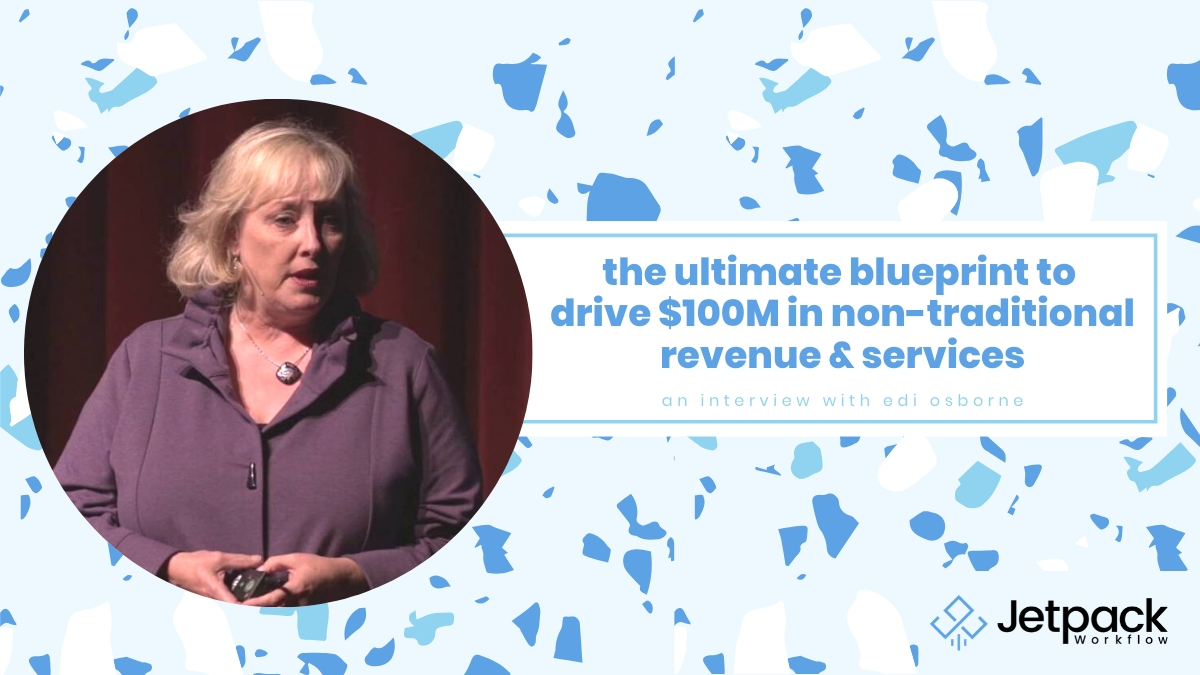The Ultimate Blueprint To Drive $100M In Non-Traditional Revenue & Services

Today’s guest is Edi Osborne, Founder of MentorPlus, who is responsible for helping Firms across North America bill and drive $100M in non-traditional revenue & services.
In this episode, we cover:
+ Each level of the Level 5 Service Model (and how you can move through each stage)
+ Common mistakes firms make when becoming a “trusted business advisor”
+ Specific strategies and tactics to improve client relationship (and retention), find additional services to offer, and much more!
+ How to drive $100M in non-traditional revenue & services with your current firm
Additional Links:
We, at Jetpack, are giving away Edi Osborne’s Book called: Firm Forward: A Journey From the Land of Compliance to a World of Reliance.
Key Summary:
A big revelation for accounting firms is that they are missing the big picture when only focusing on the financial aspects of business. So much more business opportunity is achievable when advising on a wider range of business decisions for your clients.
Come join Edi Osborne in learning how you can be part of the many firms who together have billed more than $100million in additional services and offerings to their clients.
Edi Osborne is the Founder and CEO of Mentor Plus that has been working on a cure for random acts of consulting for over 20 years. Her work has help hundreds of firms across North America transition from compliance to reliance by adopting a repeatable structure approach to delivering high value advisory services. CPA Practice Magazine has recognized Edi has one of the top 25 thought leaders and most powerful women in the accounting profession.
Edi is the author of the book Firm Forward that outlines:
- How to differentiate and grow your firm in a post-recession, new normal business environment.
- How to attract and retain ideal clients.
- How to attract, retain, and accelerate the professional development of your team members.
- How to drive $100M in non-traditional revenue & services.
And, according to Edi, a business is worth more as it evolves through the Level 5 Service model.
The Level 5 Service Model BluePrint:
“The Level 5 Service is a structured approach to delivering high-value advisory services. The practical logic embedded in the Level 5 Service makes it easy for any practitioner to immediately add value to their client relationships.”
It is a framework that addresses business metrics for your firm in a systematic way.
This model is has generated over $100 million in new, non-traditional revenue for firms across North America.
Level 1 – Service Analysis:
Level 1 categorizes the core, commoditized services that every firm provides. These services are the technical foundations when getting financial information correct. They include:
- bookkeeping,
- accounting work
- audit and taxes
“As long as it remains, commodity firms are going to have a hard time when competing at that level so I will see pricing such an issue for firms but also clients want more,” Edi says.
“Every single accounting firm I know does a Level 1 service and they do it well but you know what that is? An assumed competency.
Plus, even if you do it better and most often even when you’re better than your colleagues down the road, the client doesn’t know that and perception is everything,”
She continues by saying “if the client perceives that I can get the tax return done here or down the street and one is “x” dollars and the other is “x” times $2, you know if they don’t perceive the difference, they will go for the cheaper price every day of the week.”
Level 2 – Financial Outcomes:
Level 2 categorizes the steps necessary to achieve financial fluency and in identifying the potential opportunities. It provides business owners with ways to connect the business drivers with financial outcomes.
Level 2 is divided into two sub-categories: Level 2a and Level 2b.
Level 2a is about the understanding the financial information produced at Level 1 such as the connection between the balance sheet and the income statements and the cash flow and then conveying its meaningfulness to the client
Level 2b addresses the “what if” questions and lost opportunities by looking at the past results and identifying what do to more effectively going forward.
For example: “What if” accounts payable shrunk to 60 days instead of 75 days or if inventory was turned faster? How will these improvements enhance margins? “What if” we raise our prices and we lost 20% of our customers? What impact will that move have on business?
We, at Jetpack, are giving away Edi Osborne’s Book called: Firm Forward: A Journey From the Land of Compliance to a World of Reliance.
Level 3 – Business Direction:
Level 3 categorizes planning steps in strategizing the business direction.
Level 3 focuses on the big picture and poses the questions:
- Where do you want to be?
- How does the future look?
- How are you going to get there?
Level 3 is about conducting planning sessions with clients to help them understand what are their goals. For some, the goal may be to build the company. For others, the goal may be an exit strategy.
Level 4 – Firm Execution:
Level 4 categorizes the execution steps within the organization that are necessary to achieve those big business goals.
It involves putting in place measures, systems, and processes that engage the entire working team to improve their performance and steer the company in the direction of their overall business goal.
Engaged employees will begin to develop an ownership of these processes and an understanding of the strategic insights of the firm.
Next, implementing a way to measure whether or not the company’s goals is accomplished through building a Business Dashboard.
A Business Dashboard tracks development metrics related to these goals and systematizing the business. The Business Dashboard can be customized based on the internal audience including the CEO and COO versus the VP of Finance versus Marketing and Customer Service versus Human Resources.
“
We find when we open the door, when we bring in employees, when we engage them in this conversation, when we show to them what the big picture looks like, we raise their strategic intelligence. They become a huge management asset to the organization,” Edi assures.
Level 5 – Continous Improvements:
Level 5 categorizes ways to implement continuous improvements or better known as the Japanese concept Kaizen, a continuous improvement cycle.
This highest level is about identifying possible dysfunctions that may happen and getting ahead of the curve to improve upon them.
Edi challenges whether the business is measuring the right metrics that lead to desired improvements or the wrong measures that create undesirable outcomes.
“Think about a business that operates on Level 1 [information] versus a company that operates at Level 5 quality of information. A Level 5 company has worked through where they were going, they got the measures, they got the employees engaged they got policies and procedures that insures there’s consistency and quality throughout their organization that’s a better run organization what more at the time of sale.”
Help your clients help themselves and earn more revenue than you ever have.
It will be a winning combination for you and your clients.
We, at Jetpack, are giving away Edi Osborne’s Book called: Firm Forward: A Journey From the Land of Compliance to a World of Reliance.






